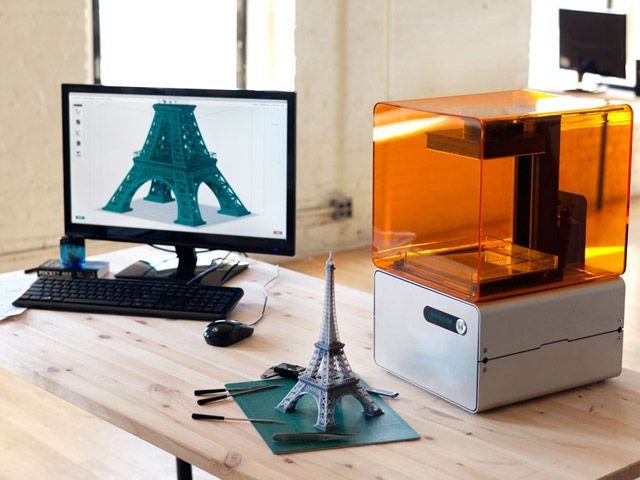FORM 1 Brings Stereolithography to the Desktop

Formlabs’ desktop SLA AM system, FORM 1. Courtesy of Formlabs.
Latest News
October 3, 2012
Lately, I’ve had the privilege to cover the release of a number of new and interesting 3D printers. Some of these additive manufacturing (AM) systems are intended for industrial use, but a few are targeted at home users and small business. MakerBot’s new Replicator 2, for instance, promises to be an excellent tool for rapid prototyping and hobbyists alike, all at a reasonable price point.
I won’t go into my spiel about 3D printing moving into homes again here, but suffice it to say that I’m a believer. I came across what I feel is more proof of this notion today in a new AM project being funded via Kickstarter, called FORM 1.
Don’t let the idea that the new AM system is a Kickstarter project fool you. Innovators are finding out mainly average folks are willing to back an idea with cash and in large enough numbers to finance even fairly ambitious projects. To date, FORM 1 has raised almost $1.5 million and it still has two weeks left on the Kickstarter funding timer.
Getting back to the 3D printer, FORM 1 is the brainchild of former MIT students. After working in the MIT Media Lab, the alumni were used to having access to high quality AM support, but, upon graduation, they found most systems that might be considered affordable for home use or small businesses didn’t meet the quality standards they had come to expect. In response, they formed a new business named Formlabs.
Formlabs’ goal is to create a desktop stereolithography (SLA) AM system with a price tag that appeals to the aforementioned small businesses and home maker crowd. Stereolithography 3D printers aren’t cheap, and can easily cost more than $100,000. The resin used to build objects using SLA isn’t any easier on the wallet. Formlabs is aiming to create a desktop SLA printer that costs $3,000 and uses a resin priced at around $150 per liter.
Concerns about the quality of less expensive AM systems is what led Formlabs to begin work on the FORM 1, and if the final product meets the standards the company is claiming, they will have succeeded. According to the company, the FORM 1 has a resolution of 300 µ, with a layer thickness of 25 µ. The build envelope is a modest 125 x 125 x 165 mm (4.9 x 4.9 x 6.5 in.), but the earliest desktop material extrusion AM systems offered a similar build area.
Assuming Formlabs can get up and running, other companies are bound to take notice, and the result will be further innovation. Competition usually brings prices down and greater material demand should drop prices on that front as well. I don’t know that SLA printers will ever be as inexpensive as material extrusion printers, or that the home audience really needs the level of precision offered by SLA, but this kind of development is certainly promising for the future.
Below you’ll find a video from Formlabs.
Source: Formlabs
Subscribe to our FREE magazine, FREE email newsletters or both!
Latest News
About the Author
John NewmanJohn Newman is a Digital Engineering contributor who focuses on 3D printing. Contact him via [email protected] and read his posts on Rapid Ready Technology.
Follow DERelated Topics







